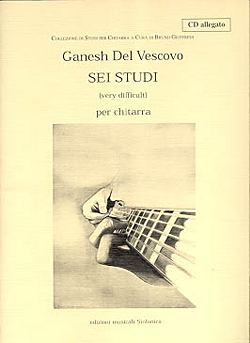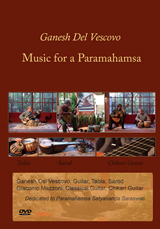IL FRONIMO – guitar review
Edizioni il Dialogo – Milano – luglio 2001
( published by IL DIALOGO − Milan, Italy − July 2001 )
An article by Alvaro Company

Ganesh Del Vescovo
Sei Studi per chitarra (Six Studies for the guitar)
Publisher: Edizioni Musicali Sinfonica, Milan, 2001
The Sei Studi (Six Studies) for the guitar by Ganesh Del Vescovo are impressive right from the very first time one glances at them or hears them. This is because of the distinct character and the unique originality each one of them bears. Each study, besides using specific and most novel techniques on the instrument, evolves through the use of several new procedures which were invented by the composer, as well as other ones that are totally new to the guitar, and which were borrowed from oriental instruments. The techniques mentioned could, through study, widen interpreters’ performing possibilities and therefore should be taken into serious consideration. The resonance of Indian Ragas and of ancient Greek modes are combined with the language of Western music in a spontaneous fusion which becomes the genuine expression of a new world of sound.
The First Study, "Invocazione a Sita" (su una nota ribattuta), on the repetition of one note, is a serene devotional tune in which measure and intuition determine the harmonious development on the thread of the melody, tuned in a mode which recalls an Indian Raga. The thread of this melody becomes the expressive representation of one’s own soul and, through wide bowing movements, there is a progressive unfolding of deep inner meditative moments that alternate with moments of great lyrical tension. A higher pitch drone note (nearly always an E played on the first string and, in the crescendos, on the first and second strings) is played with a tremolo and is often gentle and smooth, accompanying and integrating the tune which continues on lower tones.
The Second Study, "On Percussions" in the beginning unravels impetuously through rich percussion timbres, in a pattern which is played by the right hand accompanied by an obstinate succession of notes, nearly always repeated, played only with the left hand on the fingerboard of the instrument. There follows a short episode with a more tranquil dialogue between the two hands, which still remain independent. Here the left hand, by itself, (using a new and personal technique created by Del Vescovo), produces rapid arpeggio chords on the six strings. These chords are composed only of natural harmonics. During all this, the right hand, by itself, carries out the percussion. The episode which follows begins with a crescendo and an accelerando. It is here that the "pizzicato Ganesh" (or Ganesh pizzicato) appears for the first time. This is done by pressing the string on the fingerboard with one finger of the right hand and by plucking it simultaneously with another finger of the same hand (usually with the thumb). This allows the left hand full freedom to form other patterns by itself, (either notes or percussions). All this has a very strong effect.
The Third Study, "On Microtones", is composed of a musical structure which is nearly always monodic, with the exception of a few moments in which one or, more rarely, two notes remain resonant, superimposing each other on the melody pattern which continues. The indication given to use quarter tones and eighths of tones, must be considered as approximate, because of the nature of the technique used to play them. Through the effect of these "mutating tones" (especially the key-intervals in which the slight identification of a theme comes to the surface) the tune unfolds itself into a dimension in which the notes are no longer identifiable in the normal diatonic and chromatic tones, and give a hint of a transfigured sense of the Raga. In this way there arises, with surprising simplicity, a melodic line which is subtly varied, extremely expressive and genuinely fascinating.
The Forth Study, "Sandhya I" uses a particular technique of portamento, which Del Vescovo calls "Sarod glissando" and which derives from a technique used on an oriental instrument. This technique consists of pressing the string on the fingerboard with the tip on the fingernail rather than with the finger tip and then in sliding from one fret to the other (usually with rapid movements). This has the effect of a portamento legato (slur portamento) but it is more resonant. The rhythm is rather free and reminds one of a recitativo − a dialogue between two people, the first of whom seems more imperious and, at times, agitated and even impertinent (this effect is produced through the "Sarod glissando"), and the other person, with a calmer character, expresses himself through long notes (étouffés with resonance") or with a series of more tranquil slur notes (done with the normal guitar technique of the instrumental slur) or also with a succession of notes played with the effect of a pizzicato. The whole impression is that of the image of two masks of the oriental theatre which either converse with each other or argue.
The Fifth Study, "On the Ganesh Pizzicato", constantly uses this new technique, that I have already discussed in referring to the Second Study. But here the use of the technique is systematic and is always in association with other notes that, either on the same string or on another one, flow rapidly together with the normal instrumental slur played by the left hand. In this Study the various technical combinations weave in and out of each other with elegant rapidity and virtuosity. The effect is surprising because of the sonorous game of the scales which "oscillate" like recurrent waves, underlined by the musical accents which illuminate them. Technique, virtuosity and instrumental gesture come together in a happy symbiosis of mimic and sound.
The Sixth Study, "Antar Mouna" (Inner Silence) is on harmonics and ends the series. As its title suggests, this composition has a meditative character. The third string is lowered to F# so as to allow the playing of certain arpeggiati chords and a particular "resonance" in a specific modal area. This moves around a rising or falling chromatism, in a very sensitive and moving way, particulary on the II, IV and VII degrees. Though the world of the Indian Ragas can be seen throughout, in this piece the kind of resonance used seems like the reflection of the personal, discovery of an intuitive, inner world of harmoniae, found inside one’s own microcosm. In the first part the piece develops a very calm feeling of spaciousness. A few rare arpeggios, created by normal sounds, form the foundation of the transparent flowing of harmonic notes, (even very high pitch ones), that spread through a nearly star-like space of sound. In the second part the piece becomes lively and agitated, nearly to the point of becoming dramatic. Then, towards the end, it brings in an arpeggio which once again finds the traces sounds that appeared in the beginning of the piece. There follows a conclusion which consists of a delicate and short stream of notes which get more and more acute and which resemble something that we remember, which is vanishing slowly and diminishing, nearly loosing itself in space.
( Alvaro Company )
Download PDF file (right-click on the icon above and select "Save Target As...")

 Italian
Italian English
English

